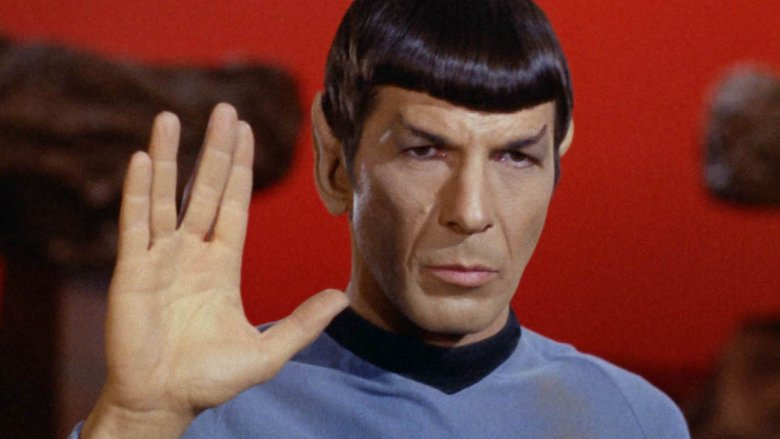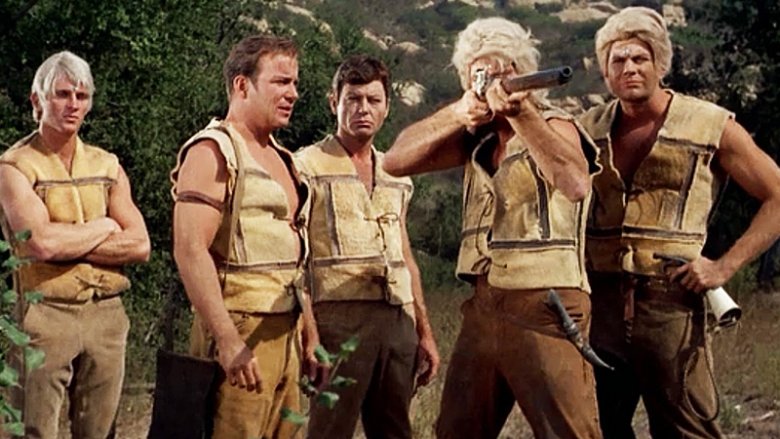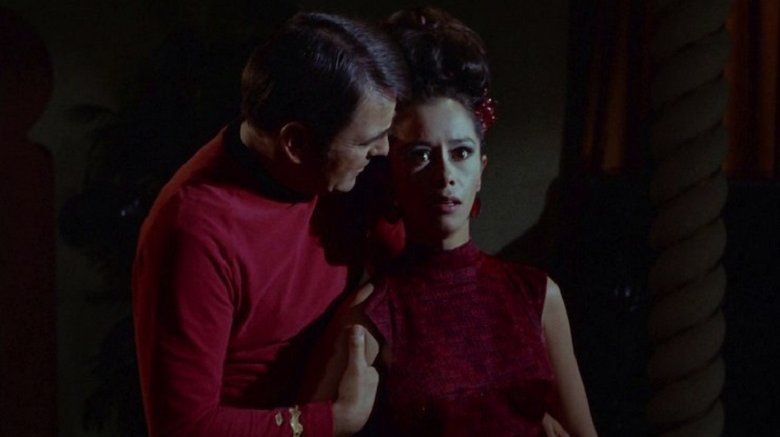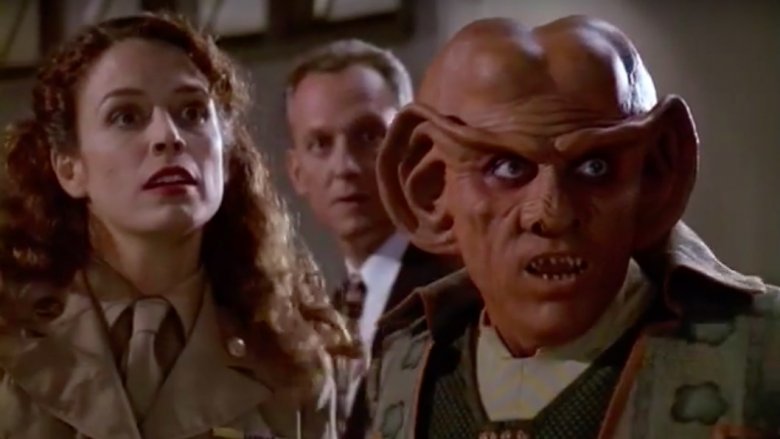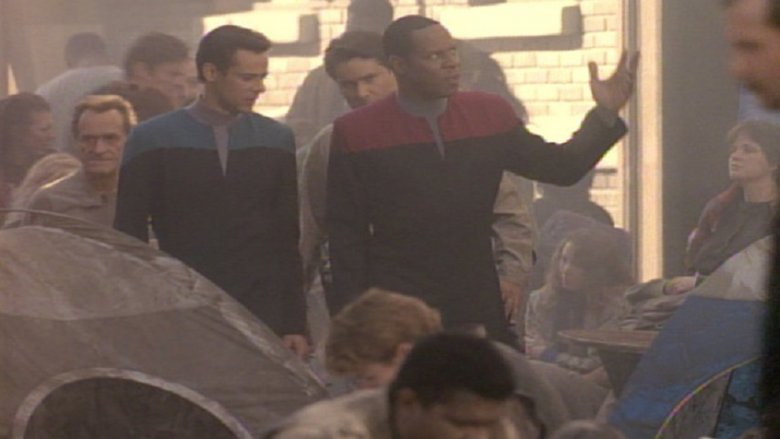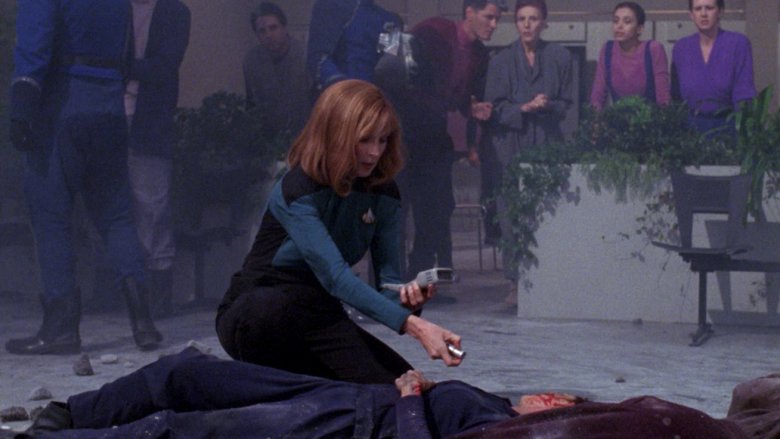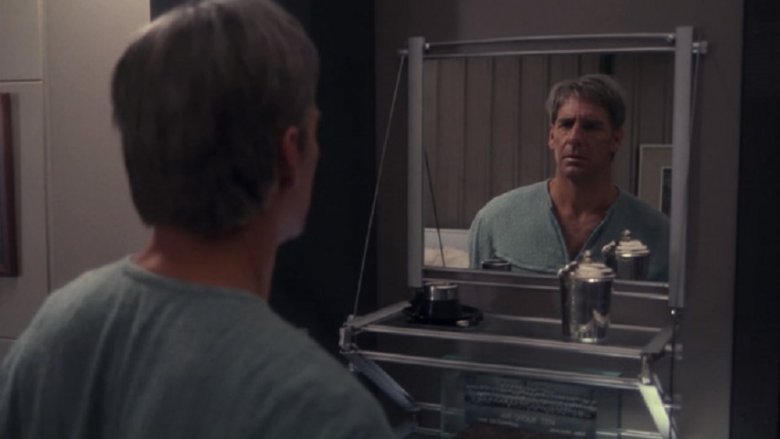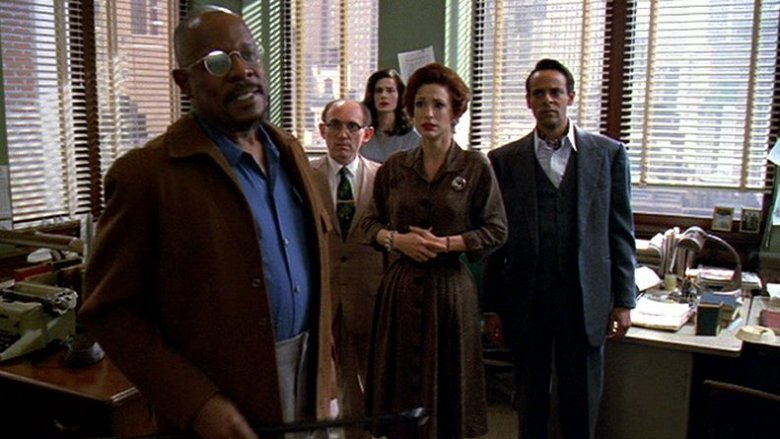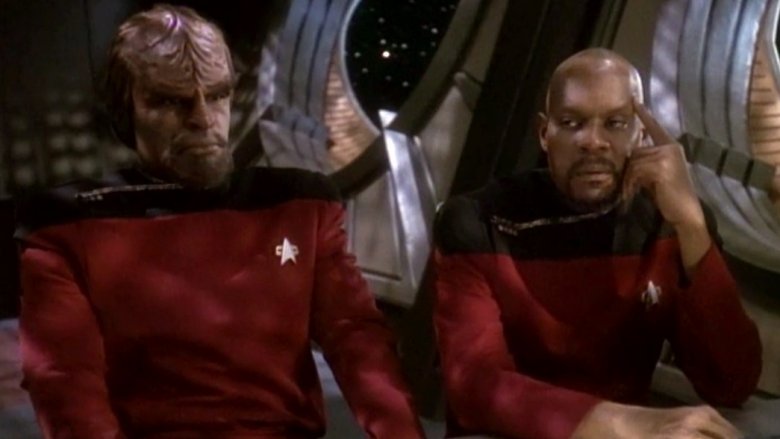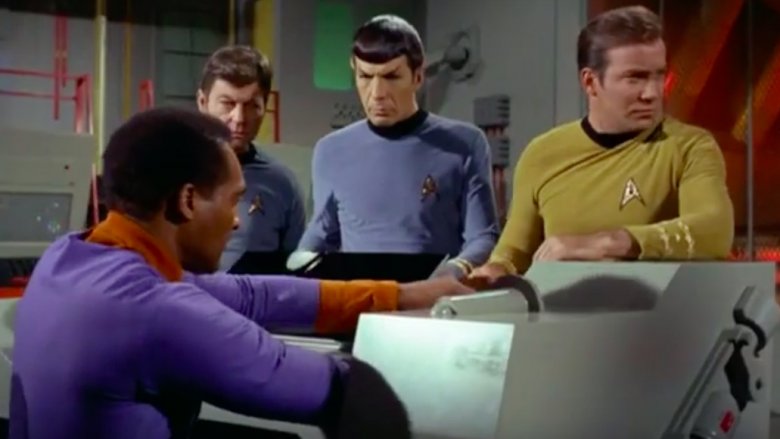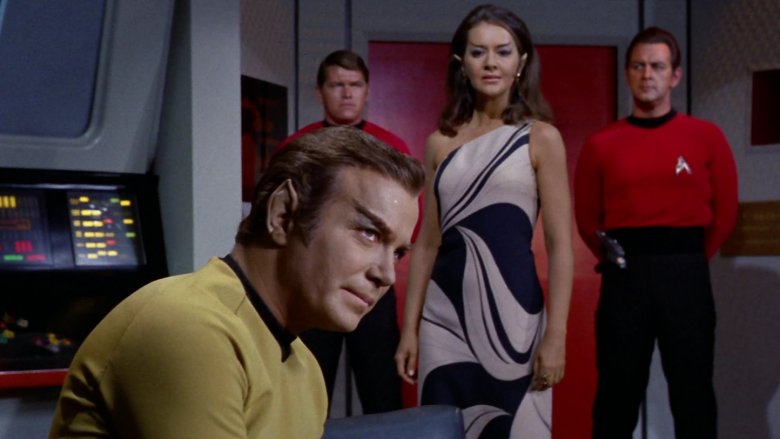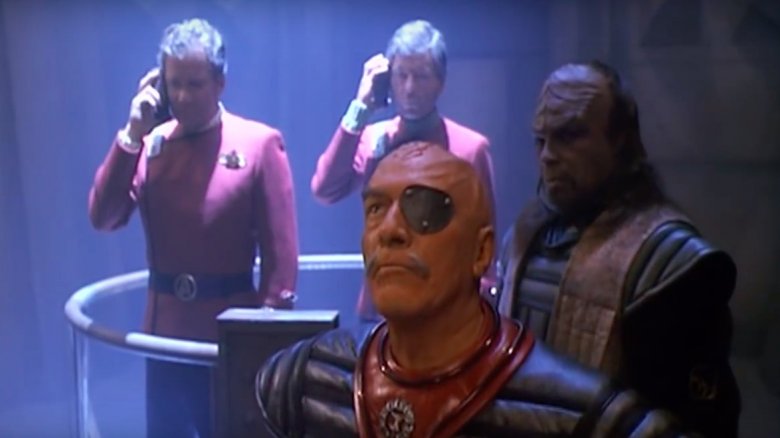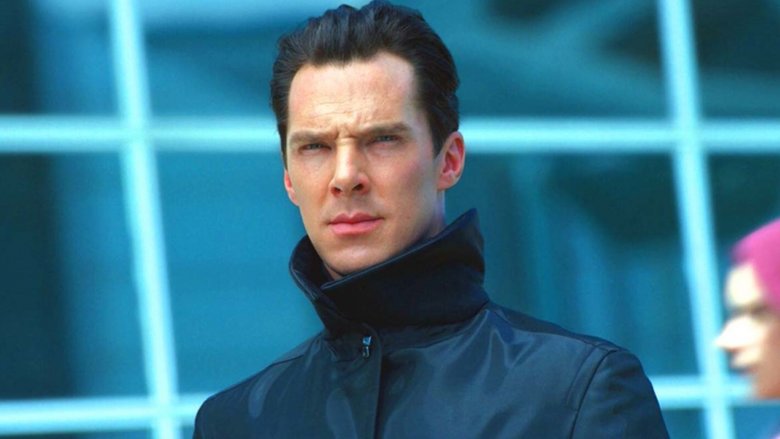True Events That Inspired Star Trek Episodes
Star Trek has always been a political franchise. Sure, the hot topics are disguised with space exploration and discovery, but every iteration of the show has used allegory to focus on social issues like war, racism, justice, and the counterculture. Some episodes (and even some of the films) have been heavily based on real life, taking past or current events and reworking them into the space-traveling storylines of the Enterprise, Voyager, and Defiant.
In fact, the behind-the-scenes Star Trek crew has done a brilliant job over the years of drawing inspiration from real life and hiding their messages in plain sight. This way, fans who don't think of themselves as political can enjoy a swashbuckling adventure in space, while everyone else can have something deep and meaningful to discuss around the water cooler. As a result, some Trekkies might not recognize the true life stories behind some of their favorite episodes, while it's embarrassingly obvious in others.
Of course, not every Star Trek reference to the real world is inherently political. Sometimes, the showrunners draw on the past to serve up incredibly interesting episodes with some historical flavor. So let's boldly go where no fan has gone before and look at some of the true events that inspired Star Trek, from the original series to the modern films.
Star Trek critiqued the Vietnam War
Star Trek loves to talk about politics and social justice, but at the same time, the original series was rather contradictorily racy, what with its long track record of ditsy women in impossibly short skirts whose best efforts at self-reliance and tenacity is to utter the words "Captain! I'm frightened!" whenever things start to go a little south.
If you've always found that sort of annoying, it might comfort you to know that Star Trek writers Herb Solow and Robert Justman often used racy content to distract the sex-obsessed television censors of the time from the show's otherwise political content. A great example of this was the second season episode "A Private Little War," in which Kirk contemplates the ethics of intervening in someone else's war. According to Brian Winston's A Right to Offend, Solow and Justman wrote in a scene where Kirk kissed a partially-dressed woman — with an open mouth, no less — solely for the purpose of drawing attention away from the actual storyline, which was thinly veiled commentary on whether or not the United States really ought to get involved in Vietnam. It was a pretty genius move, and it worked. The episode aired in February 1968, just after the Tet Offensive.
It doesn't excuse all the "Captain! I'm frightened!" crap, but hey, at least the writers were paying attention to some of the larger issues of the day.
Scotty the Ripper
Centuries after Jack the Ripper stopped terrorizing the Whitechapel district of London, we still can't stop talking about him. He's been featured in films, television shows, comic books, video games, and pretty much every other media of fiction and non-fiction you can think of. And yeah, Star Trek usually gets its inspiration from stuff that hasn't been beaten to death with a bag of Tribbles, but for some reason, it used Jack the Ripper as inspiration for the 1967 episode "Wolf in the Fold." According to The A.V. Club, the episode was written by Robert Bloch of Psycho fame, who must've been in a creative slump because otherwise why?
So here's the story. A woman causes an accident that gives Scotty a concussion, so Kirk and McCoy take him to a "pleasure planet" where he can get laid and thus prevent the disaster of him developing a "total resentment towards women." Oh-kay. Said pleasure planet turns out to look rather suspiciously like the Whitechapel district of London circa 1888, complete with foggy streets, which also why? Anyway, while they're down there, women keep getting murdered, and Scotty keeps getting found holding a bloody knife, so yeah, things aren't looking good for everybody's favorite engineer.
In case you were worried, Scotty isn't the killer because if he were, we would've missed out on decades of his hammy Scottish brogue. No, the real murderer is the actual Jack the Ripper, who as it turns out is a formless entity that needs fear and also foggy streets to survive. What a relief.
'Little Green Men' revealed the true story of Area 51
Not every based-on-a-true-story Star Trek episode is meant to be a complex political allegory on truth, justice, and hippies. Some are written simply for the purpose of being silly and entertaining. Some aren't even based on true stories. Instead, some are inspired by conspiracy theories that are probably just nonsense. (Probably.)
For example, season four of Deep Space Nine tackles the complex social problem of people who actually think the government might be hiding aliens at Area 51. In this particular episode, entitled "Little Green Men," Quark, Rom, Odo, and Nog are sent back in time to Area 51, because no one ever gets tired of "sent back in time" Star Trek episodes, nor do they ever get tired of talking about Area 51. Anyway, the episode handily explains the 1947 crash of the high-altitude balloon that spawned decades of conspiracy theories and culminated in the 2019 storming of Area 51 for what it really was — the crash of a Ferengi shuttle full of a stereotypically capitalist race of humaniod aliens with very large ears. Now let's all have some meaningful conversation about what that means for the progression of the human race and the state of capitalism in America.
The Bell Riots were based on the Attica prison riot
Sometimes big things have to happen before anyone starts paying attention to otherwise important social problems. According to History, before the riot at Attica prison in 1971, many American prisons kept inmates in deplorable conditions. At Attica, prisoners were allotted one shower a week and one roll of toilet paper a month. And let's face it, you can take away a person's freedom, you can take away his television set, you can take away his privacy, but everyone has the right to wipe his own butt.
Things came to a head when the prisoners rebelled, taking hostages and releasing a list of demands. Notably, the prisoners' list of demands didn't include "let us out of prison," but it was mostly just a plea for more humane conditions, including religious freedom, an end to the censorship of their personal correspondence, and better living conditions.
The Attica riot changed prisoner treatment in America, and it was the inspiration for a key incident in Deep Space Nine's two-part episode "Past Tense." In this time-traveling episode, writer Ira Behr drew from the Attica prison riot when constructing the 2024 "Bell Riots," an incident in which the occupants of a repressive "Sanctuary District" for homeless and unemployed people rebel, thus setting the stage for humans to finally become woke. Today "Past Tense" is remembered as one of Star Trek's most political episodes.
The troubles with 'The High Ground'
Besides being like the most understated name for political conflict in history, "the Troubles" was the phrase used to describe the sectarian conflict in Northern Ireland that happened between 1968 and 1998. If you're unfamiliar with this ugly part of history, here's a quick summary. The mostly Protestant unionists wanted Northern Ireland to remain part of the United Kingdom, while the mostly Catholic nationalists, led by the Irish Republican Army (IRA), wanted to join the republic of Ireland. The confrontation included acts of terrorism like bombing and sniper attacks, plus the deaths of around 3,600 people.
Star Trek: The Next Generation's season three episode "The High Ground" is about a violent conflict between the people of the planet Rutia IV and a bomb-planting group of rebel separatists called "Ansata." According to The Irish Post, the parallels between Ansata and the IRA are so thinly veiled that Data and Picard actually have an on-screen conversation about the parallels between Ansata and the IRA. Data even says that the conflict in Northern Ireland is an example of successful terrorism.
The episode aired in 1990, when the real conflict was still very much a thing, and the content was alarming enough to the British powers of TV that it was heavily edited in the United Kingdom and Ireland (the edits included the removal of the Data/Picard conversation). As of 2109, it has still never been shown in its entirety on the Emerald Isle.
This Star Trek episode was possibly based on a real medical case
Star Trek's habit of drawing on real life doesn't always involve politically charged events from history or commentary on the stupidity of the human race. Sometimes, the writers seem to be drawing interesting facts out of the past in order to flesh out a character or just add some depth to a story line. One such example is the similarity between the memory condition suffered by Captain Archer in the Enterprise episode "Twilight" and the story of a real-life medical case from 1953.
In the show, Archer suffers from a disorder caused by parasites that live in non-linear time, which causes all new memories to fade within a few hours. The storyline seems to be based on the case of Henry Molaison, a 27-year-old assembly worker who suffered from severe epilepsy. According to Brain Facts, Molaison underwent brain surgery to remove his hippocampus, and his seizures stopped ... but he also lost the ability to form new memories. Molaison could remember some things from the past but nothing from the moment he emerged from the surgery.
And it was all just a dream
In the Deep Space Nine episode "Far Beyond the Stars," Sisko is given a vision by the weird aliens that live in the nearby wormhole, just one of many he experiences throughout the series. In this one, he's living in 1950s Harlem, working as a sci-fi writer. During his time in his episode-long vision, he deals with racist publishers who refuse to publish his story on the grounds that it has a black protagonist, and he encounters various characters who look an awful lot like the folks he knows back home. Fortunately, the episode is blissfully free from ruby slippers and talking scarecrows.
Also, it seems very likely that the episode was inspired by the 1956 decision of the Comics Code Authority to disallow the publication of an Entertaining Comics story entitled "Judgement Day," which featured a black protagonist. Judge Charles Murphy didn't even try to disguise his decision as "too much robot on robot violence" or something that wouldn't have made him look like such a racist jerk. Instead, he said outright that he wouldn't approve the story if it had a black protagonist. Entertaining Comics published the story anyway, even though its lack of official approval meant that it wouldn't get wide distribution. After that, the racist jerk Murphy embarked on a personal vendetta against the publisher, personally reviewing everything they submitted for approval. The company went out of business a few years later.
'Rules of Engagement' was based on the true story of Iran Flight 655
In 1988, the USS Vincennes shot down Iran Air Flight 655. According to The Washington Post, the incident happened towards the end of the Iran-Iraq War while the Vincennes was exchanging fire with Iranian ships in the Persian Gulf. The official US Navy account of the incident said the passenger plane was mistaken for an enemy jet. Now, how one mistakes an Airbus A300 for an F-14 is hard to imagine but okay. It was an accident. Still, 290 civilian passengers and crew members died when the Vincennes shot two surface-to-air missiles at the plane.
In the Deep Space Nine episode "Rules of Engagement," Worf has been accused of a similar crime — destroying a civilian ship carrying 441 people. Much of the episode is a courtroom drama in which the Klingon Empire is trying to get Worf extradited for war crimes, and Sisko is trying to stop that from happening.
The story ends predictably. As it turns out, the whole thing was just a setup, and Worf actually fired on a ship full of dead bodies. As for the real-life incident, well, it's unfortunately not that black and white. Real people died on Air Flight 655, and we probably won't ever know exactly what happened.
Star Trek reacted to the inevitable rise of computers
Star Trek has often has the uncanny ability of addressing problems that we'd still be discussing decades later. One great example of Star Trek's ability to see into the future was the original series episode "The Ultimate Computer." In this episode, the Enterprise becomes the proud owner of a new computer called the M-5, which is capable of running all the ship's systems with minimal human intervention. This is immediately not cool as far as Kirk and McCoy are concerned, though Spock is rather predictably fascinated by the idea.
Even if you haven't watched the episode, you can probably see the ending coming from several million light years away. M-5 isn't really the ultimate computer. It's the ultimate murder machine, and it's also evidently too stupid to know the difference between a real battle and a mock one meant to demonstrate its abilities. It takes down another starship with lethal force and then, after Kirk convinces it that it's a murderer, shuts itself down, thus preventing a Skynet-style takeover of the Federation.
In case it's not obvious, this episode was a reaction to the rise of the computer and genuine concern about what would happen if we gave machines too much power and control. The episode deals with questions we still ask ourselves today, such as what happens when human beings automate everything, and then everyone is left without a job and a purpose?
When Star Trek drew inspiration from a military incident
Over the years, Star Trek has asked plenty of questions about war, territory, and unprovoked attacks. For example, there's "The Enterprise Incident," an episode from season three of the original show. This episode was based on the Pueblo Incident of 1968, which involved an American communications monitoring ship called the USS Pueblo and some North Korean naval vessels. The Koreans claimed the Pueblo was in Korean waters, while the US claimed it was in international waters. After the Koreans opened fire and then boarded the ship, they caught the captain rather incriminatingly destroying stuff, including electronics and documents. The crew was brought back to North Korea, where they endured 11 months of interrogation and torture.
The Star Trek version of this story is almost exactly the same. The Enterprise is just outside the Romulan Neutral Zone on an "observation mission," when a bunch of Romulan ships show up and open fire, forcing Kirk to surrender. Before the crew is taken prisoner, Kirk orders the destruction of top secret equipment. Then, he and Spock are taken to a Romulan outpost, where they're threatened with interrogation and torture. After that, the two plotlines diverge somewhat. Spock and Kirk take Romeo and Juliet-style fake suicide pills, and then Kirk and McCoy put on pointy ear disguises so they can infiltrate the Romulan outpost, which is evidently enough to make the Romulans not recognize them. Anyway, we're going to guess that none of those last bits happened during the real incident.
Mr. Gorkon, tear down that starbase!
Everyone has heard of Chernobyl, and if you haven't, it's because HBO somehow managed to miss your computer specifically when they, much like reactor No. 4, bombarded the entire internet with a devastating stream of toxic particles, err, harmless banner ads. Anyway, Star Trek couldn't possibly pass up an opportunity to comment on the Cold War in general and Chernobyl in particular, and nearly three decades before HBO's Chernobyl miniseries became a gleam in the eye of some cable TV executive, they were already creating an allegory on the incident entitled Star Trek VI: The Undiscovered Country.
In this film, there's a major explosion at an energy facility on Praxis, the Klingon moon. Just like the Russians, the Klingons pretend the accident was no big deal, because if they admit otherwise, they admit weakness, and not being weak is like the Klingons' whole deal. In the movie, the Klingon chancellor even has a familiar name: Gorkon. And in case you need a nudge, that kind of sounds like "Gorbachev." Anyway, Gorkon decides to open peace talks with the Federation, and there's even talk of dismantling the starbases and other military structures around the Neutral Zone. The real life storyline and the fake one start to diverge at this point, when someone assassinates Gorkon, and Kirk is charged with the crime. Because let's face it, no one would like the movie if the starbases came down, and everyone had a party.
Benedict Cumberbatch equals Osama bin Laden
The Cold War, the Vietnam War, hippies ... they're all a thing of the past. Today, the threats faced by modern America are a lot more sinister than all of those things precisely because they can happen anywhere, be perpetrated by anyone, and might even involve Benedict Cumberbatch.
Star Trek got a reboot in the 2000s with a once again young and super sexy crew, thus proving once and for all that in the world of the future, science has eliminated the awful scourge of people who aren't CW hot. Anyway, the reboot returned Star Trek to its roots not just in the "everyone is sexy again" way, but also in the allegorical commentary way. The storyline of the 2013 film Star Trek Into Darkness revolves around an act of terrorism, and it even considers questions about the nature of evil and the people who dedicate themselves to fighting it.
The story loosely parallels some of the events of September 11. First, there's a terrorist attack on a major city (London/New York), and then there's a leader (Admiral Marcus/Dick Cheney) who wants to launch a vengeful counter attack on an enemy that probably had nothing to do with the initial attack (the Klingons/Iraq). And if we want to go even deeper into the analogy, that would probably make Benedict Cumberbatch ... Osama Bin Laden. Well, the on-screen Cumberbatch, anyway. The real Cumberbatch seems like a pretty nice guy.
